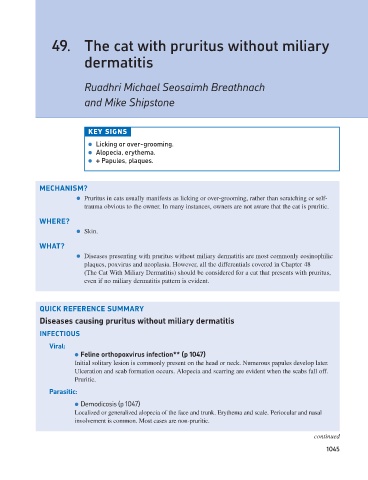Page 1053 - Problem-Based Feline Medicine
P. 1053
49. The cat with pruritus without miliary
dermatitis
Ruadhri Michael Seosaimh Breathnach
and Mike Shipstone
KEY SIGNS
● Licking or over-grooming.
● Alopecia, erythema.
● + Papules, plaques.
MECHANISM?
● Pruritus in cats usually manifests as licking or over-grooming, rather than scratching or self-
trauma obvious to the owner. In many instances, owners are not aware that the cat is pruritic.
WHERE?
● Skin.
WHAT?
● Diseases presenting with pruritus without miliary dermatitis are most commonly eosinophilic
plaques, poxvirus and neoplasia. However, all the differentials covered in Chapter 48
(The Cat With Miliary Dermatitis) should be considered for a cat that presents with pruritus,
even if no miliary dermatitis pattern is evident.
QUICK REFERENCE SUMMARY
Diseases causing pruritus without miliary dermatitis
INFECTIOUS
Viral:
● Feline orthopoxvirus infection** (p 1047)
Initial solitary lesion is commonly present on the head or neck. Numerous papules develop later.
Ulceration and scab formation occurs. Alopecia and scarring are evident when the scabs fall off.
Pruritic.
Parasitic:
● Demodicosis (p 1047)
Localized or generalized alopecia of the face and trunk. Erythema and scale. Periocular and nasal
involvement is common. Most cases are non-pruritic.
continued
1045

